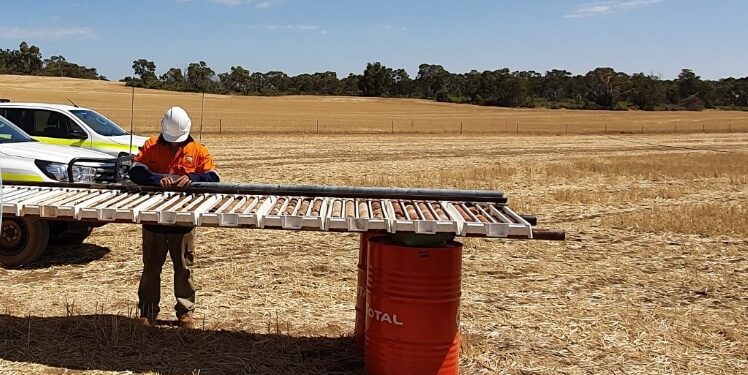Caspin Resources Limited (ASX: CPN) has intersected potentially significant mineralisation at the XC-22 anomaly at the Yarabrook Hill Prospect in its exploration activities at the Yarawindah Brook PGE-Ni-Cu Project in Western Australia.
RC drilling at the XC-22 airborne electromagnetic (AEM) anomaly intersected a sequence of intercalated gabbros and pyroxenites with intervals of peridotites hosting trace to disseminated sulphides. The mineralised zone is at least 40 m thick with up to 20% sulphides over the first 2.0m and becoming more disseminated at depth.
CEO, Greg Miles, said all reported sulphide intersections are based on visual observations.
“Whilst still early days, given the current extreme delays on assay turn-around, we felt it prudent to advise the market of the exciting visual observations at XC-22,” Mr Miles said.
“The large size of the XC-22 anomaly suggests that if it is coincident with mineralisation throughout its entire extent then this could represent a significant body of mineralisation.
“Many more drill holes are required before this can be confirmed as a significant discovery and laboratory assays are required to confirm the tenor of any PGE mineralisation that may be present.
“This is an exciting development for the Yarawindah Brook Project and the results to date have given us reason to review similar AEM anomalies in the region that, in light of this new information, are potentially significant. In addition, the remainder of the project area is about to be surveyed by AEM, commencing early in December.
“We look forward to providing further updates on RC drilling at XC-22 and the interpretation of stratigraphic diamond hole YAD0019 as they come to hand.”
A second hole, YARC0023, drilled approximately 175m along strike and down dip from YARC0022 has also intersected gabbro and pyroxenite sequences with trace to minor disseminated sulphides – except for a 2.0m zone consisting of approximately 5% sulphides with visible chalcopyrite and lesser pentlandite. This interval may correlate with the mineralised interval observed in YARC0022 at 46m.
These intersections are supported by a historical drill hole, YBR063, which intersected 5m @ 1.05g/t PGE (2E) from 43m in the interpreted primary sulphide zone, which was not assayed for nickel and copper. YBR063 is approximately 100m down section from YARC0023. Whilst this interpretation is preliminary, it may indicate the potential of the area hosting a body of mineralisation.
Mr Miles said the intersections are significant as they validate that the XC-22 AEM anomaly represents bedrock sulphides. The AEM anomaly has an apparent strike length of 500m and has not been previously targeted for drilling. Due to the nature of the AEM survey, the anomaly is currently poorly constrained. As such, the Company has commissioned new ground fixed-loop and downhole EM surveys to assist further targeting of the mineralisation intersected to date.
The geological setting appears similar to that which hosts Chalice Mining’s Gonneville Deposit, particularly with respect to a thick sequence of serpentinised ultramafic rocks.
For further information please visit: https://www.caspin.com.au/












